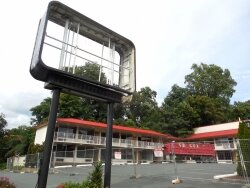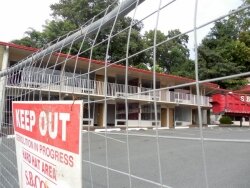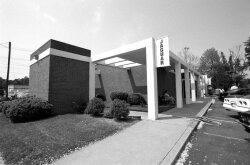Wrecking ball: EconoLodge and other buildings going down
-
 E-Gone-O-Lodge: The EconoLodge's sign is gone and the building is coming down, to be replaced by green space.photo by Lisa Provence
E-Gone-O-Lodge: The EconoLodge's sign is gone and the building is coming down, to be replaced by green space.photo by Lisa Provence -
 Preservationists and former guests found no redeeming value in the '60s-era motor lodge.photo by Lisa Provence
Preservationists and former guests found no redeeming value in the '60s-era motor lodge.photo by Lisa Provence -
 The Import Car Store was cutting-edge architecture when it was built in 1963.file photo by Jen Fariello
The Import Car Store was cutting-edge architecture when it was built in 1963.file photo by Jen Fariello
Not many will mourn the passing of the EconoLodge on Emmet Street. Even in a town that values preservation of its historic past, the now-underway demolition of the 1962 motel close to UVA elicits disappointment— only in that it won't be blown up, but instead will be taken down with a backhoe, according to a phone call to contractor S.B. Cox.
Certainly the motel's recent guests, the majority of which rated it "terrible" on TripAdvisor and complained about dirty rooms and bedbugs, won't be lamenting its demise. It's the place where former model Linda Doig was found dead in room 115 under mysterious circumstances on December 5, 2011.
The UVA Foundation bought the 1.5-acre site, which also houses the Afghan Kabob Palace, in May 2008 for $6 million. Good news for kabob lovers: The restaurant will stay, says UVA spokesperson McGregor McCance.
Renovation was not considered, says McCance. "The decision to end operation and demolish the property was, in part, made because the property was approaching the end of its physical and economic life," he says. The demolition will cost approximately $125,000, and short-term plans are to turn it into green space like the corner of University Ave and Emmet Street, which the Chevron station used to inhabit.
"There are some really pretty good examples of utilitarian mid-20th century architecture," says Justin Sarafin with Preservation Piedmont and a member of the Board of Architectural Review. "That isn't necessarily one of them. With the EconoLodge, there's not a whole lot to recommend it."
More architecturally significant and of the same era is the current Import Car Store, once a Jefferson National Bank, at 901 Seminole Trail on the corner of Hydraulic. "It's an example of mid-century modern expressionism, almost international style," says Sarafin, comparing it to another such example of that stye, the old Sears building on West Main that's now Stacy Hall.
According to a site plan filed with the city, that corner is slated to house a bank once again, but not in the current structure. Fulton Bank in Lancaster, Pennsylvania, is the applicant for a new, 5,640-square-foot building, says planner Michael Smith. Because it's on an entrance corridor, the new building will require Planning Commission review, but there's nothing to impede the demolition of the old one, says Smith.
Sarafin says Preservation Piedmont is in touch with the owners, George and Cathy Seymour, and the contractor. "It's a well-designed building," he says. "A lot more is going on there than the EconoLodge."
Like the EconoLodge, there's a bit of notoriety in the Import Car Store history. The primo corner property was purchased by the Seymours in 2001 for $762,700. In 2006, George Seymour was convicted of malicious wounding of an animal for shooting his neighbors' pet cat, Carmen, and was sentenced to 10 days in jail. The Seymours did not return phone calls from the Hook.
Several guidelines go into whether a building is historically significant and worthy of listing in the state or national registers, or is "register eligible," says Sarafin, including whether the structure is a strong example of a style or period or type, especially if that style is particularly important to a locale or region.
Another factor is whether the building is associated with a historic figure, for example, the Budget Inn on Emmet Street, which was called Gallery Court when Martin Luther King stayed there during his 1963 visit to Charlottesville. "That often times is weighed with or in combination with historical value and architectural value," says Sarafin.
Deciding which buildings are historically significant can get tricky, says Sarafin, and there's yet another consideration: the integrity of the resource. "Is there enough of the original fabric visible that if you were to preserve, it would be indicative of time, style, and place?"
In the Budget Inn example, he says, "if the building has been completely covered in vinyl, if there is not a single piece of what was there when the significant person stayed there," then its integrity is compromised.
Also on the list of upcoming demolitions: Random Row Books on West Main, built in 1933 and once a Texaco Station, faces the wrecking ball to make way for a new Marriott Residence Inn on the corner of Ridge-McIntire, which will also take down the former CityClay building. "I don't recall too much concern about that," says city preservation and design planner Mary Joy Scala of the latter.
Another West Main building with a demolition permit hanging over its head is the Blake Building on the corner of JPA, where UVA Health System is constructing the Battle Building. There are no plans to replace the Blake Building, says Scala. Sadly, it's probably too close to the new Battle Building to be blown up.
One other building likely to be unmissed on West Main is the not-even-30-years-old Republic Plaza, which the BAR unanimously okayed for demolition. Even though he voted for the permit, Sarafin cautions about taking down the 1988 structure.
"It's incredibly wasteful to demolish and rebuild," he says, noting that there's a lot of brick in the Republic Plaza.
And while the building doesn't seem particularly remarkable today, 30 years from now, "It could be a decision we regret," says Sarafin, with the current arbitrers in the future being scolded, 'Can you believe they tore down a piece of quasi-post-modern architecture?'"
3 comments
Whole lot of teenage parties over the years in that EconoLodge.
The fact that we are even half-jokingly talking about preserving an econo-lodge building means that we have gone way overboard with this historical preservation nonsense.
While I am sad that City Clay had to move from such a great location on Main & 5th, the building itself is nothing to be missed.
Buildings with historical significance can be worth saving, but just being an old building does not a historic landmark make.
Wish i could 'like' dave anthony's comment. Consider this my Thumbs Up.